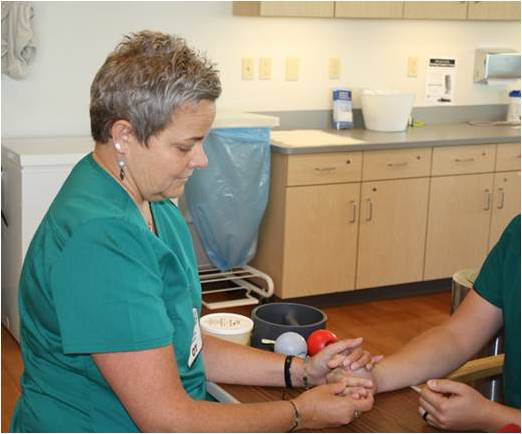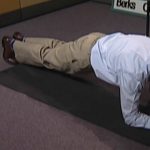Reading, Pa. — An injury to the hand can be devastating, resulting in an inability to perform basic tasks, to work or to enjoy favorite activities. Hand therapists at Penn State Health St. Joseph have seen the results of injuries to the hand again and again, and are dedicated to helping patients improve their conditions and get back to their lives.
“It’s amazing what you take for granted when it comes to your hand,” said Jennifer Neiheiser, an occupational therapist who has been certified as a hand therapist for 14 years. “Just stop and think about everything you would not be able to do if you didn’t have the use of your dominant hand.”
Hand therapists also treat wrist and elbow problems, and some address shoulder injuries, as well.
Although physicians and therapists have recognized the need for specialized therapy for patients with hand injuries since World War II, the first certification program was not established until 1991.
“It’s a relatively new specialty,” explained Monica Rush, director of rehabilitation services. “People were doing hand therapy, but there wasn’t that structure around it.”
Injuries to hands and fingers are among the most common workplace injuries, and can be complicated because of the way the hand is constructed. There are 28 bones in each hand.
“It’s a lot concentrated in a little area,” Neiheiser said. “When you think about it, your hands are your connection to the world.”
Someone working toward certification as a hand therapist is an occupational therapist with a minimum of three years of clinical experience, completion of 4,000 hours of direct practice in hand therapy, and passing of an exam. Once certified, hand therapists must complete ongoing continuing education in order to maintain their status.
Aaron Dearstyne is an occupational therapist at Penn State Health St. Joseph who is working toward becoming a certified hand therapist. It is a demanding undertaking, he said, but the work is important.
“Patients who lose the use of one or both of their hands really suffer,” Dearstyne said. “That often leads to depression because they can’t work, or support their families or enjoy the activities they used to. If we can help someone to come back from a devastating hand injury, we’re making a difference.”
A hand injury can be caused by a traumatic event, such as a hand getting caught in machinery or a fall. Hand pain also can be caused by a condition such as arthritis or carpal tunnel syndrome.
St. Joseph is seeing more patients with serious damage to their hands, such as that caused by a crush injury, because patients are being referred to the hospital from Hershey Medical Center. Four or five hand surgeons at Hershey refer patients to St. Joseph therapists, who treat over 100 patients a month on an outpatient basis.
The first step in hand therapy, said Dearstyne, is to work at healing any wounds.
“We work with the physicians and physician assistants at Hershey to make sure the wounds heal properly,” he said. “After that, we can start our work with the patient.”
One of their goals, explained Neiheiser, is to teach patients exercises they can do at home in order to assure that their progress continues.
“Our goal is always to help patients get as much function back as possible,” Neiheiser said. “So, a big part of what we do is teaching patients what they can do at home to improve function and keep their healing going.”
While patients are still being treated at the hospital, they work with therapists in a specialized setting that enables them to practice tasks of daily living and regain as much use of their hands as possible.
While the goal is complete recovery, sometimes that is not possible, Neiheiser said. In those cases, therapists become psychologists and cheerleaders, urging patients to focus on what they can do, instead of what they cannot.
“So much of it is the attitude a patient has,” she said. “If somebody is only thinking about what they can no longer do instead of about the things that they can do, they tend not to do as well. We work really hard to try to keep our patients positive.”




